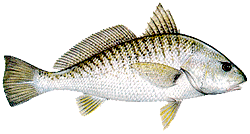

The Atlantic Croaker is a silvery greenish or grayish fish with coppery spots on its side and 6-10 small barbels on its chin. The underside of the fish is generally white. A croaker’s tail is slightly pointed, and it has faint wavy stripes across its back. Most Atlantic croakers are about 12 inches long and weigh between 1 to 2 pounds. One of the unique ways an Atlantic croaker uses its muscles is to make noise: it will vibrate its stomach and swim bladder with special muscles that make a drumming sound in the water!
As the name suggests, the Atlantic croaker is mostly found along the Atlantic coastline from Cape Cod to the Gulf of Mexico. Some croakers have been seen as far south as Brazil and Argentina. Atlantic croakers like to live at the bottom of coastal areas with shallow waters. Often they will stay near muddy areas, around rocks, or close to the piers and bridges built at the shore by humans. They can handle a wide range of temperatures from 50 degrees F all the way to 95 degrees F! Atlantic croakers eat mainly worms, small crabs, and other tiny fishes.
The Atlantic croaker turns a golden color at breeding time. It will move into southern ocean waters between September and December in preparation for breeding. Most of the mating takes place in November, when the females release over 100,000 eggs at a time into the water. The young larvae are unable to survive very salty water, so they soon return to the shores. Croakers can live up to 8 years and are ready to breed after just 1 year. However, Atlantic croakers are a common target for fishing and are often eaten by humans.